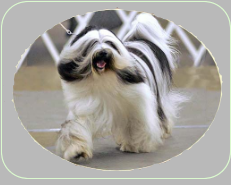
Tibetan Terrier History
The popular story of the breed’s origin states that it has remained unchanged for over 2,000 years, evolving from dogs bred at one remote monastery in what was to become the ‘Lost Valley’, cut off from the Rest of Tibet by an earthquake some hundred of years ago. A dog would be presented to each dignitary visiting this monastery from other religious establishments in distant parts of Tibet, to act as a guard and companion on the lengthy and hazardous journey home. On rare occasions a dog might also be given to lay persons as a token of esteem, or as a reward for exceptional services rendered to the monastery. The story also relates how all Tibetan Terriers in or near the Lhasa area were swiftly removed to the remote monasteries for safe keeping when the Chinese invaded and overran Lhasa early in the 18th century: and that since then no ‘true’ Tibetan Terriers have been seen anywhere near Lhasa.
They are regarded in Tibet, their country of origin, as great ‘luck bringers’.Very fascinating in their ways, and devoted little friends, they are the most treasured procession of their Tibetan owners: and in times of famine they will part with every other treasure, but still keep their dogs.
The introduction of the breed in England is due to Miss A.R.H.Greig, M.B,Ch.B who became one of the first women surgeons, and soon after the 1914-1918 war she became a member of the Women’s Medical Service in India. It was in 1922 that she made her first acquaintance of a Tibetan Terrier. She was given a puppy as a token of gratitude from a patient she had operated on, who was named ‘Bunti’. Dr. Grieg’s Tibetan friends brought a mate for ‘Bunti’ and ‘Rajah’ was the sire of her first litter born on Christmas Day 1924.
In 1926 Dr. Greig returned to England on home leave, with
Bunti and a young bitch from that first litter as well as a dog from
a second litter. The three Tibetans were accepted for registration by
the British Kennel Club as Lhasa Terriers. Both youngsters bore the
suffix ‘of Ladkok’.
Dr. Greig served in India for about twelve years: but she felt increasingly
homesick and wanted to concentrate on developing the Tibetan Terrier.
She set up a partnership in the Channel Islands with a Miss Nye, who
also became interested in the breed. Dr. Greig left Jersey about 1937
bringing her dogs to Royden, where she and her mother joined forces.
In the years following the end of the war, four ‘new’ Tibetan Terriers were accepted for registration by the British Kennel Club, all of them ‘pedigree unknown’. Three of them figure in today’s pedigree.
The past history of the breed in Tibet should not be overlooked or disregarded: it plays an essential part still in the proper maintenance of breed type. The Tibetan Terrier’s characteristics should not be diminished by fashion, ignorance or carelessness.
It may be interesting to consider the ‘four unique characteristics’ present in the native-bred dogs with which Dr.Greig founded the breed:
- Eye placed exactly halfway between the point of the nose and the occipital protuberance at the back of the skull’.
- ‘A double coat, the outer of the texture of human hair, the under of wool, which could be and was shed independently of the outer coat’.
- ‘An absolutely flat foot with no vestige of an arch’.
- ‘The characteristic gait, which is due to the dog’s flat feet’.
Extracts taken from ‘‘The Tibetan Terrier by “Angela Mulliner. .
